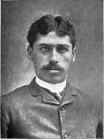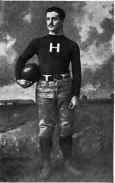American Football. Continued
Description
This section is from the book "American Football", by Walter Camp. Also available from Amazon: American Football.
American Football. Continued
At first the play was crude in the extreme, but even in its earliest stages it proved distinctly more satisfactory to both player and spectator than the kicking and shoving which marked the English method.
The same man did not always snap the ball back as he does now, but any one of the rushers would do it upon occasion. The men did not preserve their relative positions in the line, and any one of the men behind the line would act as a quarter-back. Such a condition of affairs could not, however, last long where intercollegiate rivalry proved such an incentive to the perfection of play, and the positions of centre-rush or snap-back and quarter-back became the most distinctive of any upon the field. The centre-rush at that time was selected more for his agility, strange to say, than for his weight and strength; but in case he was a light man he was always flanked by two heavy guards. One season's play convinced all captains that the centre section of the forward line must be heavy, and if any light-weights were to be used among the rushers they should be near the wings.
Quarter-back has, from the very outset, been a position in which a small man can be used to great advantage. The halfbacks and backs have usually been men of speed coupled with skill as kickers.
The number originally adopted for matches in this country was eleven on a side. From some silly notion that it would increase the skill displayed, this number was changed to fifteen, although the Englishmen were moving in the other direction by reducing their numbers from twenties to fifteens. A year or two of fifteen on a side drove the American players back to elevens, and there the number has rested.

Harvard.
In the early days of the sport, while the players individually were courageous, the team play was cowardly; that is, the tacticians were so taken up with a study of defence-how to protect the goal-that the attack was weak. The direct result of this was to place too few men in the forward line and too many behind it. If to-day we were to revert to fifteen on a side, there is little doubt that we should throw eleven of them up into the rush line, and upon occasion even twelve. We now realize that the best defence does not consist in planning how to stop a man after he has obtained a fair start towards the goal, but in throwing all available force up against him before he can get free of the forward line. The only way to effectively defeat this aggressive defence is by means of skilled kicking. It is possible with really good kickers to throw a team playing in this fashion into disorder by well-placed and long punting, followed up most sharply; but it requires nerve and an unfailing accuracy of aim and judgment.
It is only a few years ago that it required considerable argument to convince a captain that he could with safety send one of his halves up into the forward line when his opponents had the ball; but it will take better kicking than is exhibited in most of the championship matches to frighten that halfback out of the line now. Even the quarter was wont upon occasion to drop back among the halves and assist them rather than the rushers.
All the tendency for the last two years has been towards diminishing the number of men held in reserve, as it were, behind the line, and increasing by this means the crushing force by which the forwards might check either runner or kicker before his play could be executed.
Should the English ever adopt an outlet for their scrimmage, making the play as direct as is ours, their men would gravitate to the forward line as rapidly as have our players.
Next to the difference in scrimmage outlet between our game and that of the British stands a much more recent development, which we call interference. This is the assistance given to a runner by a companion or companions who go before him and break a path for him or shoulder off would-be tacklers. This, to the Englishman, would be the most detestable kind of off-side play, and not tolerated for an instant upon any field in the United Kingdom.
Even into this the Americans did not plunge suddenly, but rather little by little they stepped in, until it was necessary to do one of two things-either legalize what was being tacitly consented to, or penalize it heavily. The result was that it was legalized. With this concession, though, there went a certain condition which gained a measure of confidence for the new ruling.
To understand just how this state of affairs above mentioned came about one should know that, in the attempt to block opponents when the quarter-back was receiving and passing the ball, the forwards fell into the habit of extending their arms horizontally from the shoulder, as by this method each man could cover more space. For a number of years this went on without detriment to the sport in any way, but after a time there was more or less complaint of holding in the line, and it was ruled that a man must not change his position after the ball was snapped, nor bend his arms about an opponent at such a time. Unfortunately the referee (for at this stage of the game there was no umpire) could not watch the ball and the players with sufficient care to enforce this ruling, and the temper of the players suffered accordingly. It is always the case when a rule is not enforced unflinchingly, no matter from what cause, that both sides suffer, and the tendency always is towards devising additional infringements.
The additional infringement in this instance was even worse than could have been foreseen; for, not content with simply blocking or even holding an opponent until the quarter should have passed the ball in safety, the players in the forward line saw an opportunity for going a step farther, and actually began the practice of seizing an opponent long after the ball had been played, and dragging him out of the way of the running half-back. In the thick of the rush line this was frequently possible without risk of discovery by the referee; and, emboldened by successes of this kind, men would reach out even in the open, and drag back a struggling tackier just as he was about" to lay his hands upon the runner. It was this state of affairs which brought up the question, "How much should a comrade be allowed to aid the runner?"

Yale.
American football legislators answered this question satisfactorily, after long discussion, by determining that the runner might be assisted to any extent, provided the assistant did not use his hands or arms in performing this office. The first result of this was to lower the arms of the rushers when lined up, and, in spite of some forebodings, this proved really a benefit to the game. The second result has been to perfect a system of flanking a runner by companions who form almost an impassable barrier at times to the would-be tacklers.
At the same time with mention of the solution of this problem, one should also call attention to a menace which threatened American football far more seriously than did this; and that, too, at a time when the sport was by no means so strong in years or popularity as when this later difficulty arose. I refer to the "block game." This method of play, which consisted in a succession of "downs" without advance and without allowing the opponents any chance of securing possession of the ball, proved a means by which a weak team could avoid defeat. The whole object of the match was thus frustrated, the game resulting in no score.
To meet this difficulty a rule was introduced making it incumbent upon a side to advance the ball five yards or retreat with it ten in three "downs." If this advance or retreat were not accomplished, the ball went at once into the possession of the opponents. Never did a rule in any sport work so immediate and satisfactory a reform as did this five-yard rule.
Within the last few years there has been no important change in the conduct of the American game, nor in the rules. Outside of the above-mentioned points of difference between it and the English game, there is only that of the methods of enforcing rules and determining differences. The English have a referee and two umpires, although the umpires are sometimes replaced by touchjudges. The umpires act, as did the judges in our game of ten years ago, as advocates for their respective sides, and it is this advocacy which is causing them to fall into disfavor there exactly as they did here. Touch-judges merely watch the lines of the field, and decide when and where the ball goes into touch. In cases where they are employed, the referee renders all decisions upon claim of the captains. In our method there is a division of labor, but along different lines. Our two officials, the umpire and referee, have their separate provinces, the former ruling upon the conduct of players as to off-side and other offences, while the latter determines questions of fact as to when the ball is held or goes into touch, also whether a goal is kicked or not.
As the rule has it, the umpire is judge for the players, and the referee for the ball.

Harvard.
Continue to:


